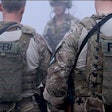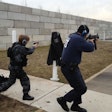"In this world nothing is certain but death and taxes."
— Benjamin Franklin
Benjamin Franklin's wise words ring true every April 15, the deadline for filing income taxes in America. But what about the death part of the quote?
So, I checked the Officer Down Memorial Page (odmp.com) to see if there have been any law enforcement fatalities on April 15th. Sure enough, when I clicked on the Website for April 15th, there were 59 law enforcement officer line-of-duty deaths listed from 1857 to 2004—32 from gunfire.
Two deadly April 15th incidents leapt off the pages of the Website—one old and one new.
Modern Day
The new was the April 15, 2003, shooting death of Pittsburg (Calif.) PD Inspector Raymond Giacomelli. While checking an empty house, the scene of a recent murder, he was surprised by the suspect, who murdered the officer execution-style. Two days later, during a stakeout, a task force in Modesto, Calif. confronted the suspect, who opened fire on them and was killed by return gunfire.
Tragically, two years later, on April 24, 2005, Pittsburg (Calif.) PD officer Larry Lasater was shot and killed by bank robbers. Both tragedies hit close to home for me, since I live in a suburb near Pittsburg. And both have a loose connection with SWAT since they involved manhunts culminating in armed confrontations.
Old West
The old was the April 15, 1872 shooting deaths of eight U.S. marshals in Talhequah, Okla., the capitol of the Cherokee Nation—an incident known as the Going Snake Massacre. With the exception of 9/11, this incident may be the deadliest in U.S. law enforcement history, yet it's virtually unknown outside the U.S. marshals and Old West history buffs.
It began as an Old West "lover's triangle" that resulted in the shooting death of a female and wounding of her male companion. Even back in the Old West, jurisdiction played a significant role in the American justice system. The suspect turned himself in to face a Cherokee tribal court. However, there was doubt about the trial being fair, and the U.S. marshals were requested to monitor the proceedings.
This is where the story takes a turn for the worse. A posse of 10 U.S. marshals rode by horseback to the Cherokee schoolhouse the day the murder trial was scheduled. The makeshift courtroom was packed with armed men from opposing sides. Although the marshals intended only to monitor the proceedings, three of them were members of the slain woman's family. Needless to say, emotions were running very high—on both sides. Certainly not the best situation for the U.S. marshals to be in the middle of.
Versions of what happened next vary. However, one accepted version is that the 10 U.S. marshals approached the schoolhouse on horseback and attempted to enter on foot. The schoolhouse had the "high ground" advantage, above the open approach. Suddenly, armed men emerged from the schoolhouse front door and opened fire on the marshals, who were caught in the open without cover.
Caught by surprise, the outnumbered marshals returned fire and engaged their assailants in a furious gunfight. When the smoke cleared, the marshals had killed three attackers and wounded six more, but lost a staggering seven marshals. An eighth marshal died the following day.
The furious gun battle continued until the marshals had been completely overwhelmed. But not until they had shot an additional 14 attackers, eleven of whom would die within days. The staggering death toll was 22 (8 U.S. marshals and 14 attackers). Incredibly, the original murder suspect was acquitted the next day in a Cherokee court (the ruling accepted by U.S. courts).
But the story doesn't end here. Ultimately, the now acquitted murder suspect received amnesty from any additional charges. Next, he was elected Cherokee Senator in 1877, followed by being elected Sheriff in 1894. The ultimate irony was he served as a deputy U.S. marshal from 1891-4 under "Hanging Judge" Parker.
The relevance to the Going Snake Massacre to today is a staggering eight U.S. marshals were killed, along with eleven suspects, a death toll of 22 in what may be the bloodiest gunfight in the history of the Old West.
There are certain parallels between the posses of the Old West and today's SWAT. Those 10 U.S. marshals were battle-hardened, had a plan, and worked as a team—yet, they found themselves in the gunfight of their lives with an enemy with superior firepower, willing to fight to the death.
Let's hope none of us ever has to face what the U.S. marshals faced on April 15, 1872. But if we do, let's hope we're the ones left standing when the smoke clears.
"Learn from yesterday, live for today, look to tomorrow."












